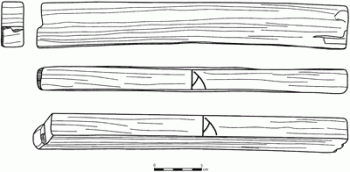American Journal of Archaeology | The Journal of the Archaeological Institute of America
You are here
Classical Greek Measures and the Builder’s Instruments from the Ma‘agan Mikhael Shipwreck
April 2006 (110.2)
Classical Greek Measures and the Builder’s Instruments from the Ma‘agan Mikhael Shipwreck
Two wooden measuring instruments, a dual-standard builder’s rule and a builder’s square, were excavated in 1985 in an ancient shipwreck off the coast of central Israel. The ceramic assemblage aboard dated the wreck to ca. 400 B.C.E. The preserved cargo was mostly stone, whose analysis indicated an origin in the Bay of Karystos, Euboea, and in the Kouris delta in southern Cyprus. The two instruments found on the shipwreck are the earliest preserved classical Greek measuring tools. In this paper, the two units represented on the rule are identified as a Pheidonian and a Solonian foot, whose ratio may be correlated precisely to a statement by Aristotle about the metrological reform of Solon. The square used a shorter unit, identical to a measure known from Hellenistic and Roman times as the Italic foot, whose length was five sixths of a Pheidonian foot. The notched subdivisions on the square suggest its originating standard was perhaps an archaic Greek foot, or 3 ft. multiple—a yard—first mentioned by Hesiod. The three standards represented on the shipwrecked tools indicate that Greek architects of the fifth century B.C.E. used multiple linear measures, traceable to diverse sources.
Classical Greek Measures and the Builder’s Instruments from the Ma‘agan Mikhael Shipwreck
By Robert R. Stieglitz
American Journal of Archaeology Vol. 110, No. 2 (April 2006), pp. 195–203
DOI: 10.3764/aja.110.2.195
© 2006 Archaeological Institute of America


